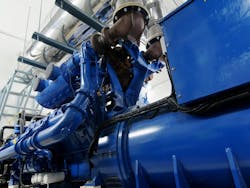US DOE Allots $10M to Combined Heat & Power Projects for Manufacturers
The U.S. Department of Energy (DOE) plans to allot up to $10 million to seven combined heat and power (CHP) projects, some of them CHP microgrids, to explore the technology’s use by small-to-midsize manufacturers.
CHP is considered a highly efficient form of distributed energy because it uses the waste heat created during power production. In conventional generation systems, the waste heat is discarded. But in CHP systems it is used to heat or cool buildings or water or to create steam. CHP systems therefore use one fuel (usually natural gas) to produce two forms of energy – power and heat.
In announcing the award, the DOE noted CHP’s role in supplying supplemental power during natural disasters, lowering energy costs, easing strain on the grid, and balancing the intermittency of renewable energy.
The technology is widely used by large industrial facilities and college campuses that have operators to run the plants, but less so by small-to-midsize facilities without expert staff. So the DOE is focusing the funds on the smaller facilities.
The $10 million will be used for research on CHP technologies, including CHP microgrids, in terms of power electronics and control systems and electricity generation components.
The DOE lists the award winners as:
- Clemson University, Clemson, SC — To develop a power conditioning system converter and a corresponding control system for flexible CHP systems. It will enable high speed gas turbines to more effectively provide grid support functions and could be readily applied in new CHP installations or potentially retrofit some applications.
- ElectraTherm, Flowery Branch, GA — To develop a high temperature organic rankine cycle (ORC) generation unit to provide additional power when needed by the grid, while also maintaining useful thermal energy for use in CHP applications. The ORC developed under this project will overcome the current limitation of useful thermal energy after the bottoming cycle.
- GE Global Research, Niskayuna, NY — To develop a set of full-size grid-interface converter system and control solutions to interconnect small-to-midsize CHP engines to the low-voltage to medium-voltage utility grid. The enhanced microgrid controller would enable engagement of a CHP system operator with the electric power grid operator through generator or microgrid controls.
- Siemens, Princeton, NY — To develop an improved CHP system by demonstrating key novel components with computer simulations of standard technologies. The project will use a supercritical carbon dioxide bottoming cycle to increase electrical output to respond to grid requests. The approach will optimize design of power systems, develop some key components (advanced heat exchangers) and demonstrate their performance in actual rig tests to prove the feasibility of the complete system.
- Southwest Research Institute, San Antonio, TX — To expand the operational window of gas turbines for greater turndown, allowing for more flexibility in the power/heat ratios and enable grid support by CHP systems. This will be accomplished by developing a low-emission combustion system capable of sustaining combustion during high turndown operation. The project focuses on the Solar Titan 130 combustor and will expand the operating window to allow for turndown to 30-40 percent load.
- University of Tennessee, Knoxville, TN – To develop a power conditioning system converter and a corresponding control system for flexible CHP systems. The power conditioning system (converter and controller will support different kinds of CHP sources, and will be scalable to form at needed power to serve as the interface connector between CHPs and a medium voltage (MV) grid. This project provides foundational work that could allow various CHPs/distributed energy resources to work together and interface directly with the utility medium voltage grid. The technology could support multiple device CHP microgrids in the future.
- Virginia Polytechnic Institute, Blacksburg, VA — To modular, scalable medium voltage power converter featuring stability-enhanced grid-support functions for future flexible CHP systems operating in small-to midsize U.S. manufacturing plants. The project provides foundational work on power electronics and control systems enabled by advanced WBG technology. It is capable of being implemented into a variety of existing and future CHP systems using a wide range of prime mover technologies.
Learn more about CHP microgrids by subscribing to the free Microgrid Knowledge newsletter.
About the Author
Elisa Wood
Editor-in-Chief
Elisa Wood is the editor and founder of EnergyChangemakers.com. She is co-founder and former editor of Microgrid Knowledge.
